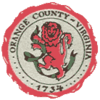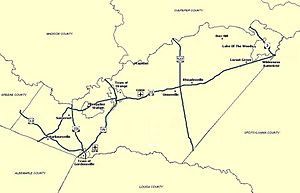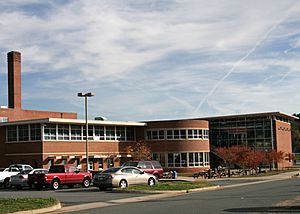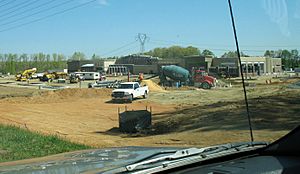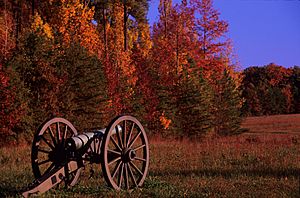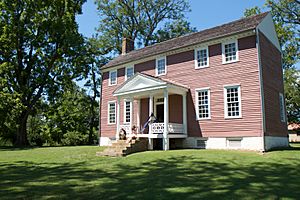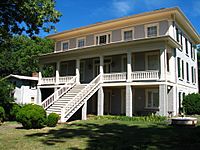Orange County, Virginia facts for kids
Quick facts for kids
Orange County
|
||
|---|---|---|

Orange County Courthouse
|
||
|
||
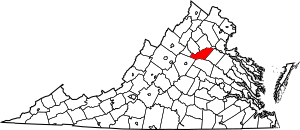
Location within the U.S. state of Virginia
|
||
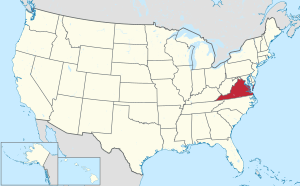 Virginia's location within the U.S. |
||
| Country | ||
| State | ||
| Founded | 1734 | |
| Named for | William III of England | |
| Seat | Orange | |
| Largest town | Lake of the Woods | |
| Area | ||
| • Total | 343 sq mi (890 km2) | |
| • Land | 341 sq mi (880 km2) | |
| • Water | 2.5 sq mi (6 km2) 0.7% | |
| Population
(2020)
|
||
| • Total | 36,254 |
|
| • Density | 110/sq mi (40/km2) | |
| Time zone | UTC−5 (Eastern) | |
| • Summer (DST) | UTC−4 (EDT) | |
| Congressional district | 7th | |
Orange County is a county located in the central Piedmont region of Virginia. In 2020, about 36,254 people lived here. Its county seat (the main town for government) is Orange. Orange County is home to Montpelier, a large estate that belonged to James Madison. He was the 4th President of the United States and is often called the "Father of the Constitution". The county celebrated its 290th birthday in 2024.
Contents
- History of Orange County
- Geography of Orange County
- Transportation in Orange County
- Population and People
- Education in Orange County
- Government and Politics
- Economy of Orange County
- Historic Places in Orange County
- Media in Orange County
- Communities in Orange County
- Notable People from Orange County
- See also
History of Orange County
The land that is now Orange County was lived in for thousands of years by different groups of Native American people. When Europeans first arrived, the Ontponea tribe, who spoke a Siouan language, lived in this Piedmont area.
Early European Settlement
The first European settlement in Orange County was Germanna. It was started in 1714 by Governor Alexander Spotswood. He brought 12 families, a total of 42 people, from Westphalia, Germany, to live there.
Orange County officially began in August 1734. The Virginia House of Burgesses decided to divide Spotsylvania County. Unlike other counties, Orange County's western border was "the utmost limits of Virginia." This meant it stretched all the way to the Mississippi River and the Great Lakes! Some people believe Orange County was once the largest county ever. This huge size only lasted four years. In 1738, most of the western part became Augusta County. The large size was meant to encourage people to settle further west. It also helped Virginia claim land against the French.
Orange County During Wars
No major battles of the American Revolution happened in Orange County. However, two groups of 50 men from Orange County joined the Culpeper Minutemen. One group fought in the Battle of Great Bridge in December 1775. The county also helped the Continental Army by providing money, salt, horses, guns, and food.
During the Civil War, the towns of Orange and Gordonsville were important centers for railroads and hospitals for the Confederacy. General Robert E. Lee often rode through the county. His army, the Army of Northern Virginia, spent the winter of 1863–64 in Orange County. The Rapidan River became a defense line.
The 1863 Battle of Mine Run and the 1864 Battle of the Wilderness both took place in eastern Orange County. These battles happened as Union troops moved towards the Confederacy's capital. The Battle of the Wilderness was a very important turning point in the war.
Growth and Development
Orange County grew with the building of railroads in the 1840s and 1850s. These railroads helped the county's farms and businesses. They carried crops and timber to cities like Richmond and Washington D.C. The Orange and Alexandria Railroad and Virginia Central Railroad were very important.
In 1838, Greene County was created from the western part of Orange. The Town of Orange became a legal town in 1834. It had been the county seat for almost 100 years. Gordonsville became an official town in 1870.
After the Civil War, the railroads were rebuilt. Farming continued, but with more livestock and dairy. This was because these types of farming needed less labor. Also, the railroads could deliver these products to bigger markets quickly. The county's population has grown steadily since the 1930s.
In 1991, a large area in the western part of the county was named the Madison-Barbour Rural Historic District. This area includes James Madison's Montpelier and other historic places.
Geography of Orange County
According to the U.S. Census Bureau, Orange County covers about 343 square miles. Most of this is land, with about 2.5 square miles of water. The land has rolling hills that get higher as you go west towards the Blue Ridge Mountains. The highest point is Cowherd Mountain, which is about 1,196 feet high.
Orange County's rivers flow into the Rappahannock River and the York River. Both of these rivers eventually drain into the Chesapeake Bay.
Neighboring Counties
- Madison County – to the northwest
- Culpeper County – to the north
- Spotsylvania County – to the east
- Louisa County – to the south
- Albemarle County – to the southwest
- Greene County – to the west
Water Bodies
- The Rapidan River forms the northern border of the county.
- Lake Orange is a 124-acre public lake southeast of the Town of Orange.
- Lake of the Woods, Virginia includes a 500-acre main lake and a smaller 35-acre lake called Keaton's Lake.
Protected Areas
- The Wilderness Battlefield is in the eastern part of the county. It is part of the Fredericksburg & Spotsylvania National Military Park.
Transportation in Orange County
Main Roads
 US 15
US 15 US 33
US 33 US 522
US 522 SR 3
SR 3 SR 20
SR 20 SR 231
SR 231
Airports
- Orange County Airport (OMH)
- Gordonsville Airport (GVE)
Public Transport
- The Town of Orange Transit (TOOT) offers bus service. It connects the towns of Orange and Gordonsville.
Population and People
| Historical population | |||
|---|---|---|---|
| Census | Pop. | %± | |
| 1790 | 9,921 | — | |
| 1800 | 11,449 | 15.4% | |
| 1810 | 12,323 | 7.6% | |
| 1820 | 12,913 | 4.8% | |
| 1830 | 14,637 | 13.4% | |
| 1840 | 9,125 | −37.7% | |
| 1850 | 10,067 | 10.3% | |
| 1860 | 10,851 | 7.8% | |
| 1870 | 10,396 | −4.2% | |
| 1880 | 13,052 | 25.5% | |
| 1890 | 12,814 | −1.8% | |
| 1900 | 12,571 | −1.9% | |
| 1910 | 13,486 | 7.3% | |
| 1920 | 13,320 | −1.2% | |
| 1930 | 12,070 | −9.4% | |
| 1940 | 12,649 | 4.8% | |
| 1950 | 12,755 | 0.8% | |
| 1960 | 12,900 | 1.1% | |
| 1970 | 13,792 | 6.9% | |
| 1980 | 18,063 | 31.0% | |
| 1990 | 21,421 | 18.6% | |
| 2000 | 25,881 | 20.8% | |
| 2010 | 33,481 | 29.4% | |
| 2020 | 36,254 | 8.3% | |
| U.S. Decennial Census 1790-1960 1900-1990 1990-2000 2010 2020 |
|||
2020 Census Information
| Race / Ethnicity | Pop 2010 | Pop 2020 | % 2010 | % 2020 |
|---|---|---|---|---|
| White alone (NH) | 27,033 | 27,389 | 80.74% | 75.55% |
| Black or African American alone (NH) | 4,206 | 4,304 | 12.56% | 11.87% |
| Native American or Alaska Native alone (NH) | 80 | 92 | 0.24% | 0.25% |
| Asian alone (NH) | 240 | 311 | 0.72% | 0.86% |
| Pacific Islander alone (NH) | 15 | 18 | 0.04% | 0.05% |
| Some Other Race alone (NH) | 49 | 156 | 0.15% | 0.43% |
| Mixed Race/Multi-Racial (NH) | 719 | 1,813 | 2.15% | 5.00% |
| Hispanic or Latino (any race) | 1,139 | 2,171 | 3.40% | 5.99% |
| Total | 33,481 | 36,254 | 100.00% | 100.00% |
Note: The US Census counts Hispanic/Latino people as an ethnic group. This table separates them from racial categories.
2010 Census Information
In 2010, there were 33,481 people living in Orange County. The population grew by 29% since 2000. This made it one of the fastest-growing counties in Virginia.
About 82.4% of the people were White, and 12.7% were Black or African American. About 3.4% of the population was Hispanic or Latino.
The average age in the county was 42.6 years. About 22.9% of the population was under 18 years old. The average household had 2.55 people.
Education in Orange County
Schools in Orange County are managed by Orange County Public Schools. Dr. Daniel Hornick is the current superintendent. The school board has five elected members, one from each district.
Elementary Schools
- Gordon-Barbour Elementary
- Lightfoot Elementary
- Locust Grove Elementary
- Locust Grove Primary
- Orange Elementary
- Unionville Elementary
Middle Schools
- Locust Grove Middle
- Prospect Heights Middle
High Schools
- Orange County High School
Higher Education
Germanna Community College has a large campus in Locust Grove. It offers programs like Nursing and Allied Health. The campus has classrooms, labs, and a wellness center. It is part of the Virginia Community College System.
Government and Politics
National Government
Orange County is part of Virginia's 7th congressional district. It is represented by Congresswoman Abigail Spanberger.
State Government
The county is represented by Bryce Reeves (R) in the 17th district of the Virginia State Senate. It is represented by Nick Freitas (R) in the 62nd district and Phillip Scott (R) in the 63rd district of the Virginia House of Delegates.
Since 1952, the county has mostly voted for Republican candidates in national elections. Republican presidential candidates have won most elections here. The last Democratic presidential candidate to win Orange County was Harry S. Truman in 1948.
Local Government
Orange County is governed by a five-person Board of Supervisors. Each member is elected from their own district. They serve four-year terms. The Board appoints a County Administrator to manage daily operations. Theodore (Ted) L. Voorhees has been the County Administrator since April 2020.
In 2024, the Board of Supervisors members were:
- R. Mark Johnson, District 1 (Chairman)
- Ed Van Hoven, District 2
- Keith Marshall, District 3 (Vice Chairman)
- Crystal Hale, District 4
- Bryan Nicol, District 5
Economy of Orange County
Orange County businesses made over $200 billion in sales in 2012. The top industries by sales were food and beverage stores, restaurants, gas stations, general stores, and car dealers. The top industries by jobs were local government, retail, manufacturing, hotels and food services, and wholesale trade.
Small businesses are very important here. About 65% of all businesses in Orange County have four or fewer workers.
Farming is a big part of the county's economy. Orange County is Virginia's top producer of nursery plants, greenhouse products, flowers, and sod. Horse farming and forestry are also large parts of the agricultural economy. Tourism is also growing, especially for history, wine, and farm visits.
Unemployment in Orange County has usually been lower than the United States average. The highest-paying industries in 2012 were finance and insurance.
Wine Industry
Parts of Orange County are in the Monticello Viticultural Area. This means it's a special region for growing wine grapes. Four wineries are located in the county: Barboursville Vineyards, Horton Vineyards, Chateau MerrillAnne, and Reynard Florence Vineyard. In 2012, Orange County had 214 acres of land used for wine grapes. This was the third highest in Virginia. The amount of grapes grown has increased a lot since 2004. This shows how much the wine industry in Virginia is growing.
Community Development:
In 2008, Wal-Mart wanted to build a large store near the National Park Service boundary of the Wilderness Battlefield. Many people and groups, like the National Trust for Historic Preservation, were concerned. They worried about increased traffic and more development near the historic battlefield. A lawsuit was filed to stop the project. Famous people like actor Robert Duvall and filmmaker Ken Burns also spoke out against it.
In 2011, Wal-Mart decided not to build the store at that location. They agreed to buy the land without developing it. They also agreed to find another site in the county. The lawsuit was then dismissed. Wal-Mart chose a new location about 4 miles west of the original site, in the Germanna area of Locust Grove. The new store opened in July 2013. The groups who opposed the first site approved of the new location. Wal-Mart also gave some of the original land to the state for historic preservation.
Historic Places in Orange County
In 2013, Orange County had 34 sites listed on the National Register of Historic Places. These include Barboursville, the Germanna Site, and the historic downtown areas of Orange and Gordonsville.
The James Madison Museum
This museum is the first in the United States to honor James Madison. It is located in a building from 1929. The museum collects and saves items from rural Virginia's past. It also helps people learn about James Madison and others who helped the region. Exhibits include items from presidents, a Black History Room, and a large Hall of Agriculture and Transportation.
The Wilderness Battlefield
The Battle of the Wilderness was fought in Orange County from May 5–7, 1864. This was the first time Generals Ulysses S. Grant and Robert E. Lee fought each other in the Civil War. The battle was very intense, with over 160,000 troops fighting. More than 23,000 soldiers were killed or wounded. After the battle, Grant's army continued south.
Today, the Wilderness Battlefield is part of the Fredericksburg and Spotsylvania National Military Park. This park has saved about 2,773 acres of the original battlefield.
Ellwood Manor
Ellwood Manor is the only house that still stands from the Battle of the Wilderness in May 1864. During the battle, it was used by the Union Army. Union General Grant had his headquarters nearby. Ellwood also played a role in the Battle of Chancellorsville in 1863. Confederate General Stonewall Jackson was wounded there. His arm was amputated and buried in the family cemetery at Ellwood. After the battle, Ellwood became a Confederate hospital.
In 2008, Ellwood was named "Favorite Virginia Civil War Site."
Montpelier
Montpelier is the 2,700-acre estate of James Madison. He was the 4th President of the United States and is known as the "Father of the Constitution." His father built the first part of the home around 1764. Later, two big additions were made in 1800 and 1812.
The National Trust for Historic Preservation has owned Montpelier since 1984. From 2003 to 2008, a $25 million renovation was done. This brought the home and grounds back to how they looked in 1820, when James and his wife Dolley lived there. Montpelier became a National Historic Landmark in 1960. It has been on the National Register of Historic Places since 1966. Both James and Dolley Madison are buried in the family cemetery on the property.
The Exchange Hotel
The Exchange Hotel in Gordonsville is a well-preserved example of 19th-century Georgian architecture. It is a living piece of Civil War history. Built in 1860 as a hotel, it quickly became the Gordonsville Receiving Hospital during the Civil War. Because it was near a major railroad and battlefields, it treated over 70,000 wounded soldiers.
After the war, during Reconstruction, it was known as the Freedman's Bureau Hospital. It served newly freed slaves. The building later became a hotel again. In 1971, it was restored and turned into a museum. It is the only Civil War-era receiving hospital still standing in Virginia.
Receiving hospitals during the Civil War were like triage centers. They gave short-term medical care. Then, doctors sent patients to other towns or hospitals. These hospitals were usually in big cities or where patients changed transportation.
Media in Orange County
The local newspaper is the Orange County Review, which comes out weekly. Regional newspapers include the The Free Lance Star from Fredericksburg, the Culpeper Star-Exponent, and the Charlottesville Daily Progress. WVCV is a radio station licensed to Orange. The county also gets radio stations from the Fredericksburg and Charlottesville areas.
Communities in Orange County
Towns
Census-Designated Place
Unincorporated Communities
- Barboursville
- Burr Hill
- Eheart
- Lahore
- Locust Grove
- Montpelier Station
- Nasons
- Rapidan
- Rhoadesville
- Somerset
- Unionville
Notable People from Orange County
- James Barbour, the 18th Governor of Virginia, US Senator, and United States Secretary of War
- Lewis R. Bradley, second Governor of Nevada; born in Orange County.
- Nannie Helen Burroughs, a Black American educator and businesswoman.
- Elijah Craig, a Baptist minister who fought for religious freedom.
- Chris Haney, Major League Baseball pitcher.
- Dwayne "The Rock" Johnson, actor and professional wrestler; has a home in the county.
- Patrick Kilpatrick, actor.
- Edna Lewis, a Black American cookbook author and chef.
- James Madison, the 4th President of the United States and "Father of the Constitution."
- Randolph Scott, western film actor.
- James Taliaferro, former U.S. senator for Florida.
- Zachary Taylor, 12th President of the United States.
- Eugene Williams Sr. (born 1942), author, educator, and inventor.
See also
 In Spanish: Condado de Orange (Virginia) para niños
In Spanish: Condado de Orange (Virginia) para niños
- National Register of Historic Places listings in Orange County, Virginia
- Orange Volunteer Fire Company


